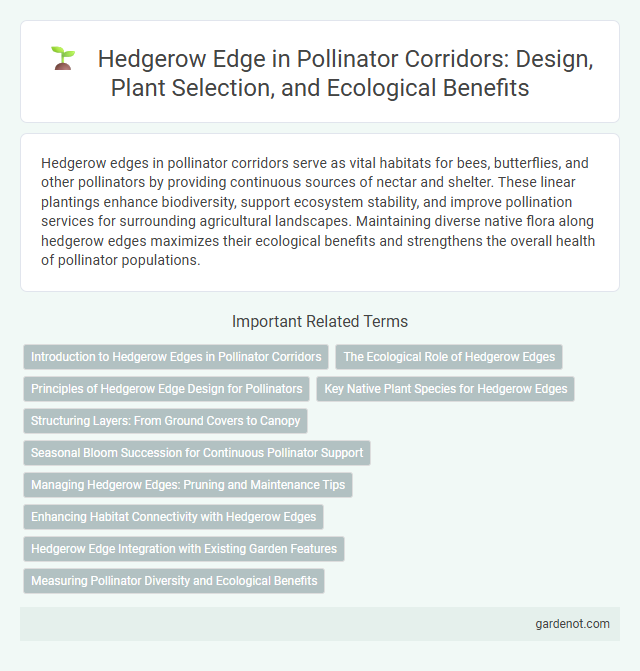Hedgerow edges in pollinator corridors serve as vital habitats for bees, butterflies, and other pollinators by providing continuous sources of nectar and shelter. These linear plantings enhance biodiversity, support ecosystem stability, and improve pollination services for surrounding agricultural landscapes. Maintaining diverse native flora along hedgerow edges maximizes their ecological benefits and strengthens the overall health of pollinator populations.
Introduction to Hedgerow Edges in Pollinator Corridors
Hedgerow edges serve as critical habitats within pollinator corridors, providing essential resources such as nectar, pollen, and shelter for a diverse range of pollinators including bees, butterflies, and hoverflies. These linear landscape features enhance connectivity between fragmented habitats, promoting pollinator movement and genetic diversity. Establishing and maintaining hedgerow edges supports ecosystem services like crop pollination and biodiversity conservation.
The Ecological Role of Hedgerow Edges
Hedgerow edges serve as critical pollinator corridors by providing diverse floral resources and nesting habitats essential for bees, butterflies, and other pollinators. These linear habitats enhance biodiversity, facilitate species movement across fragmented agricultural landscapes, and support ecosystem services such as crop pollination. Maintaining and restoring hedgerow edges increases landscape connectivity, promoting resilient pollinator populations and sustaining agricultural productivity.
Principles of Hedgerow Edge Design for Pollinators
Hedgerow edge design for pollinators prioritizes plant diversity, incorporating native flowering species that bloom sequentially to provide continuous nectar and pollen throughout the seasons. Structural complexity is essential, offering varied heights and textures to support different pollinator species while providing shelter and nesting opportunities. Maintaining pesticide-free zones along the hedgerow edges enhances habitat quality and promotes pollinator health and biodiversity.
Key Native Plant Species for Hedgerow Edges
Hedgerow edges serve as critical habitats and movement pathways for pollinators, supported by native plant species such as Ceanothus spp., Salix spp. (willows), and Ribes spp. (currants and gooseberries). These species provide essential nectar and pollen sources throughout different seasons, enhancing pollinator diversity and ecosystem resilience. Incorporating diverse native shrubs and wildflowers into hedgerow edges promotes habitat connectivity and sustains pollinator populations effectively.
Structuring Layers: From Ground Covers to Canopy
Hedgerow edges create a vital pollinator corridor by integrating multiple structuring layers, from diverse ground covers to dense canopy foliage. These layers provide essential foraging resources, nesting habitats, and protective shelter for a variety of pollinators, including bees, butterflies, and hummingbirds. Incorporating native flowering plants, shrubs, and trees enhances biodiversity and supports ecosystem resilience within agricultural landscapes.
Seasonal Bloom Succession for Continuous Pollinator Support
Hedgerow edges designed with seasonal bloom succession provide continuous nectar and pollen resources essential for diverse pollinator species throughout the year. Early spring blossoms from native shrubs like willow and blackthorn support emerging bumblebees and solitary bees, while summer flowers such as hawthorn and wild roses sustain honeybees and butterflies. Late-season bloomers like ivy and goldenrod ensure food availability during fall, maintaining robust pollinator populations critical for ecosystem health and agricultural productivity.
Managing Hedgerow Edges: Pruning and Maintenance Tips
Managing hedgerow edges involves regular pruning to enhance pollinator habitat while maintaining plant health and structure. Prune hedgerows during late winter or early spring to encourage new growth and flowering, which supports bees, butterflies, and other pollinators. Consistent maintenance prevents overgrowth, improves air circulation, and ensures the corridor remains an effective wildlife refuge.
Enhancing Habitat Connectivity with Hedgerow Edges
Hedgerow edges serve as vital pollinator corridors by linking fragmented habitats and facilitating insect movement, which supports biodiversity and crop pollination. These linear plantings of native shrubs and trees create continuous shelter and foraging resources, enhancing habitat connectivity across agricultural landscapes. Integrating hedgerow edges into land management can significantly improve pollinator health and ecosystem resilience.
Hedgerow Edge Integration with Existing Garden Features
Integrating hedgerow edges with existing garden features enhances biodiversity by providing continuous habitats for pollinators like bees, butterflies, and hoverflies. Hedgerows along garden boundaries act as natural corridors, connecting flower beds, vegetable patches, and lawn areas to support pollinator movement and foraging. Strategic planting of native shrubs and flowering plants within hedgerows strengthens ecosystem services while complementing the garden's design and structure.
Measuring Pollinator Diversity and Ecological Benefits
Hedgerow edges serve as critical habitats for diverse pollinator species, supporting increased biodiversity and ecosystem stability. Measuring pollinator diversity along these corridors involves systematic surveys of species richness, abundance, and foraging activity to assess ecological health. Quantifying ecological benefits includes evaluating pollination services, habitat connectivity, and enhancement of plant reproductive success within adjacent agricultural and natural landscapes.
Hedgerow edge Infographic

 gardenot.com
gardenot.com